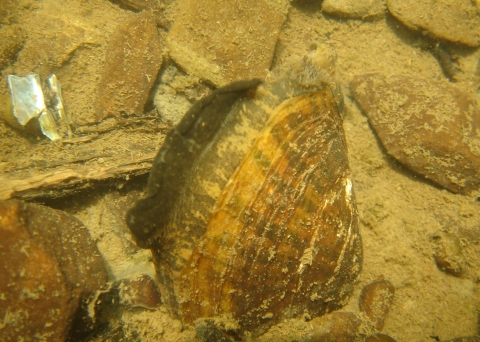Arkansas supports one of the most diverse mussel faunas west of the Mississippi River. Mussels are an important component of biological communities found in the State’s rivers and streams. They inhabit the bottom of rivers and streams and possess a fascinating life cycle dependent on fish. As part of their reproductive cycle, mussels developed unique lures that mimic fish and macroinvertebrates to attract host fish. When the fish attacks the lure, the female releases larvae, known as glochidia, that attach to the fish’s gills until they mature into juveniles (typically a few weeks) and fall to the river’s bottom.
Mussels provide a number of benefits to the health of our rivers and streams. Most notably, their filter feeding removes potentially harmful algae, bacteria, and chemical compounds. The natural waste product produced by mussels in turn serves as food for aquatic insects. Mussels are also important in diets of muskrats and raccoons. In dense concentrations, mussels play a major role in stabilizing the physical features of a stream, thereby reducing the probability of severe erosion of stream bottoms and banks.
Despite their importance to rivers and streams, freshwater mussels are one of the most imperiled taxonomic groups in North America. Of the nearly 90 species of native freshwater mussels that occur in Arkansas, 51 are considered state species of greatest conservation need and 17 are federally threatened, endangered, or proposed for listing under the Endangered Species Act.
We are working with our partners to conserve mussels using a method of mussel culture that utilizes an outdoor cage system suspended in a lake environment. This system provides a natural food source and eliminates intensive daily care and feeding that would be necessary in a laboratory or hatchery setting. Current culture at Greers Ferry National Fish Hatchery, Norfork National Fish Hatchery, and the Lake Ouachita Net Pen Facility includes species such as the endangered Snuffbox, Speckled Pocketbook, and Ouachita Rock Pocketbook, threatened Arkansas Fatmucket, and several species of state conservation concern.
